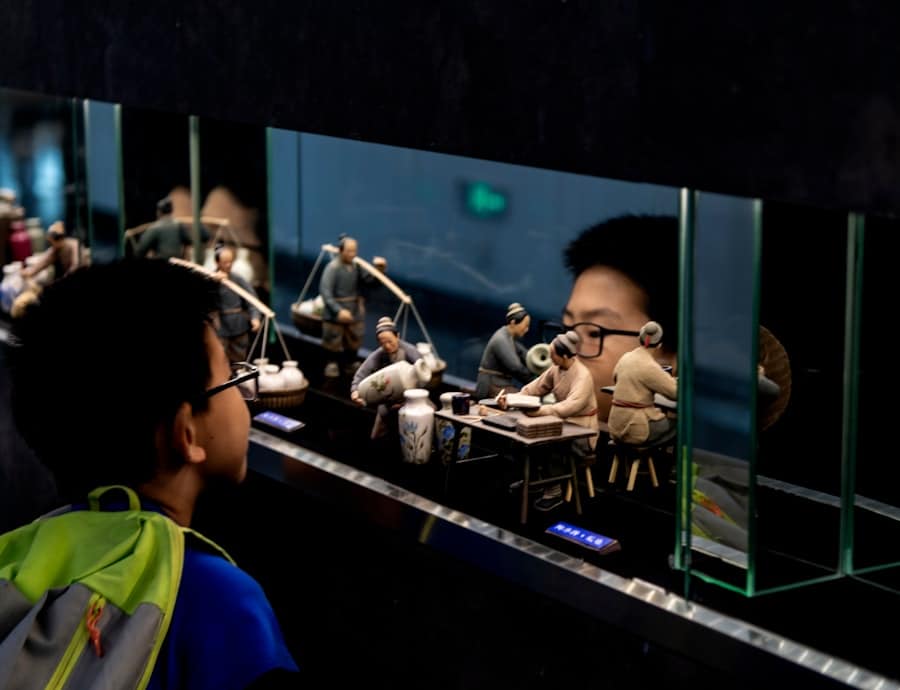Augmented Reality (AR) has emerged as a transformative technology in various sectors, and museums are no exception. By overlaying digital information onto the physical world, AR creates immersive experiences that can significantly enhance the way visitors interact with exhibits. This technology allows museums to bridge the gap between static displays and dynamic storytelling, offering a more engaging and informative experience.
As cultural institutions strive to attract diverse audiences and adapt to the digital age, AR presents an innovative solution that not only captivates visitors but also enriches their understanding of art, history, and science. The integration of AR into museum settings is not merely a trend; it represents a fundamental shift in how cultural narratives are conveyed. Traditional museum exhibits often rely on text panels and artifacts to communicate their stories, which can sometimes lead to passive engagement.
In contrast, AR invites visitors to actively participate in their learning journey. By using smartphones or AR glasses, guests can access additional layers of information, animations, and interactive elements that bring exhibits to life. This interactive approach not only enhances the educational value of museum visits but also caters to the preferences of a tech-savvy audience that increasingly seeks out immersive experiences.
Key Takeaways
- AR technology enhances museum exhibits by overlaying digital content onto the physical environment, creating an immersive and interactive experience for visitors.
- Benefits of AR in museums include increased engagement, enhanced learning experiences, and the ability to bring artifacts to life through interactive storytelling.
- Examples of AR-enhanced museum exhibits include virtual reconstructions of historical sites, interactive 3D models of artifacts, and augmented reality tours that provide additional information and context.
- AR technology is integrated into museum displays through mobile apps, handheld devices, and AR glasses, allowing visitors to access additional content and information as they explore the exhibits.
- The impact of AR on visitor engagement and learning is significant, as it encourages active participation, deeper exploration, and a more personalized experience for each visitor.
- Challenges and limitations of AR in museum exhibits include the need for reliable technology, potential distraction from the physical artifacts, and the cost of implementing and maintaining AR systems.
- Future trends and innovations in AR-enhanced museum exhibits may include more seamless integration of AR technology, personalized content based on visitor preferences, and the use of AR for collaborative and social experiences.
- In conclusion, AR technology plays a crucial role in shaping the future of museum experiences by offering new ways to engage visitors, enhance learning, and bring history and culture to life in innovative and immersive ways.
Benefits of AR in Enhancing Museum Exhibits
One of the primary benefits of AR in museums is its ability to provide contextual information that deepens visitors’ understanding of exhibits. For instance, when viewing a historical artifact, visitors can use AR applications to see reconstructions of how the item was used in its original context. This contextualization transforms a simple display into a rich narrative experience, allowing guests to visualize historical events or cultural practices that would otherwise remain abstract.
By providing layers of information that can be accessed on demand, AR empowers visitors to engage with exhibits at their own pace and according to their interests. Moreover, AR can cater to diverse learning styles, making museum experiences more inclusive. Visual learners may benefit from animated graphics that illustrate complex concepts, while auditory learners can listen to narrated stories or expert commentary through their devices.
Kinesthetic learners can interact with virtual objects or simulations that allow them to experiment and explore. This multifaceted approach not only enhances comprehension but also fosters a sense of agency among visitors, encouraging them to take ownership of their learning experience. As museums strive to accommodate a wide range of audiences, AR serves as a powerful tool for creating personalized and meaningful interactions.
Examples of AR-Enhanced Museum Exhibits
Several museums around the world have successfully implemented AR technology to enhance their exhibits, showcasing the potential of this innovative approach. The Smithsonian National Museum of Natural History in Washington, D.
, offers an AR experience called “Skin and Bones,” where visitors can use their smartphones to see lifelike animations of skeletons in motion. This interactive feature not only captivates younger audiences but also provides educational insights into the anatomy and behavior of various species, making the learning experience both fun and informative.
Another notable example is the British Museum’s “Museum of the Future” initiative, which incorporates AR into its exhibits to explore ancient civilizations. Visitors can point their devices at specific artifacts to unlock 3D reconstructions and animations that depict how these items were used in daily life thousands of years ago. This immersive storytelling approach allows guests to connect with history on a personal level, fostering a deeper appreciation for the cultural heritage represented in the museum’s collection.
How AR Technology is Integrated into Museum Displays
The integration of AR technology into museum displays involves a combination of hardware and software solutions designed to create seamless user experiences. Museums typically employ AR applications that can be downloaded onto visitors’ smartphones or accessed through dedicated devices provided on-site. These applications utilize computer vision and image recognition technologies to identify specific objects or markers within the museum environment, triggering the display of digital content when viewed through a device’s camera.
In addition to mobile applications, some museums are exploring the use of AR headsets or smart glasses that provide hands-free access to augmented content. These devices can overlay digital information directly onto the user’s field of vision, allowing for a more immersive experience without the need for handheld devices. For example, the Louvre Museum in Paris has experimented with AR headsets that guide visitors through its vast collection while providing contextual information about each artwork in real time.
This integration not only enhances accessibility but also allows for a more fluid exploration of the museum’s offerings.
The Impact of AR on Visitor Engagement and Learning
The impact of AR on visitor engagement is profound, as it transforms passive observation into active participation. By encouraging visitors to interact with exhibits through their devices, museums can foster a sense of curiosity and exploration that enhances the overall experience. Studies have shown that visitors who engage with AR content are more likely to retain information and develop a deeper understanding of the subject matter.
This increased engagement is particularly beneficial for younger audiences who may find traditional museum formats less appealing.
The emotional connection established through interactive storytelling can lead to increased interest in cultural topics and encourage lifelong learning.
For instance, when visitors can visualize historical events or interact with virtual representations of ancient artifacts, they are more likely to develop a personal connection to the material. This emotional engagement not only enriches the museum visit but also promotes ongoing dialogue about art, history, and science in everyday life.
Challenges and Limitations of AR in Museum Exhibits
Infrastructure Challenges
High-quality AR experiences require robust Wi-Fi networks and sufficient bandwidth to support multiple users simultaneously accessing digital content. However, some museums may struggle with outdated technology or limited resources, hindering their ability to offer seamless AR experiences.
Accessibility and Inclusivity Concerns
While AR has the potential to enhance learning for many visitors, it may inadvertently exclude those who are less familiar with technology or who do not own smartphones capable of running AR applications. Museums must consider how to make these experiences accessible to all audiences, including those with disabilities or those who may not have access to personal devices.
Ensuring Inclusive AR Experiences
Developing alternative methods for engaging these visitors is essential for ensuring that AR does not become a barrier but rather an enhancement to the museum experience. By addressing these challenges, museums can harness the full potential of AR to create engaging, inclusive, and accessible experiences for all visitors.
Future Trends and Innovations in AR-Enhanced Museum Exhibits
As technology continues to evolve, so too will the possibilities for AR in museums. One emerging trend is the integration of artificial intelligence (AI) with AR applications, allowing for more personalized experiences based on visitor preferences and behaviors. AI algorithms could analyze user interactions within the museum environment and tailor content recommendations accordingly, creating a customized journey through exhibits that aligns with individual interests.
Another exciting innovation is the potential for collaborative AR experiences that allow multiple visitors to interact with shared digital content simultaneously. This could foster social engagement among guests as they explore exhibits together, sharing insights and discoveries in real time. For example, groups could participate in interactive challenges or games that encourage teamwork while learning about specific topics related to the exhibits they are viewing.
Moreover, advancements in haptic feedback technology could enhance the tactile experience of AR interactions. By incorporating physical sensations into virtual experiences—such as vibrations or temperature changes—museums could create even more immersive environments that engage multiple senses. This multisensory approach would further blur the lines between physical and digital realms, offering visitors an unparalleled level of engagement.
The Role of AR in Shaping the Future of Museum Experiences
As museums continue to navigate the challenges posed by changing visitor expectations and technological advancements, augmented reality stands out as a powerful tool for enhancing cultural experiences. By transforming static displays into dynamic narratives, AR fosters deeper connections between visitors and exhibits while promoting active engagement and learning. The successful integration of this technology into museum settings not only enriches individual visits but also contributes to broader conversations about art, history, and science in society.
Looking ahead, it is clear that AR will play an increasingly vital role in shaping the future of museum experiences. As institutions embrace innovation and seek new ways to connect with diverse audiences, augmented reality will serve as a bridge between past and present, allowing visitors to explore cultural heritage in ways that were previously unimaginable. The ongoing evolution of this technology promises exciting possibilities for museums as they strive to inspire curiosity and foster a love for learning among all who walk through their doors.
If you are interested in exploring the world of 3D animation to enhance your museum exhibits, you may want to check out this article on the best software for 3D animation. This software can help you create stunning visual displays that will captivate your audience and bring your exhibits to life in a whole new way.
FAQs
What is AR?
AR stands for Augmented Reality, which is a technology that superimposes digital information such as images, videos, or 3D models onto the real world, typically viewed through a smartphone or tablet.
How does AR enhance museum exhibits?
AR enhances museum exhibits by providing interactive displays that allow visitors to engage with the exhibits in a more immersive and educational way. It can overlay additional information, animations, or interactive elements onto the physical exhibits, providing a richer and more engaging experience for visitors.
What are the benefits of using AR in museum exhibits?
Some benefits of using AR in museum exhibits include increased visitor engagement, enhanced educational experiences, the ability to provide additional context and information about exhibits, and the potential to attract a wider and younger audience.
How does AR technology work in museum exhibits?
AR technology in museum exhibits typically works by using a smartphone or tablet app that recognizes specific markers or objects within the exhibit space. When the app detects these markers, it overlays digital content onto the real-world view through the device’s camera, creating an augmented reality experience.
Are there any downsides to using AR in museum exhibits?
Some potential downsides to using AR in museum exhibits include the need for visitors to have access to compatible devices and apps, the potential for technical glitches or malfunctions, and the challenge of integrating AR seamlessly with the physical exhibits without detracting from the overall museum experience.



